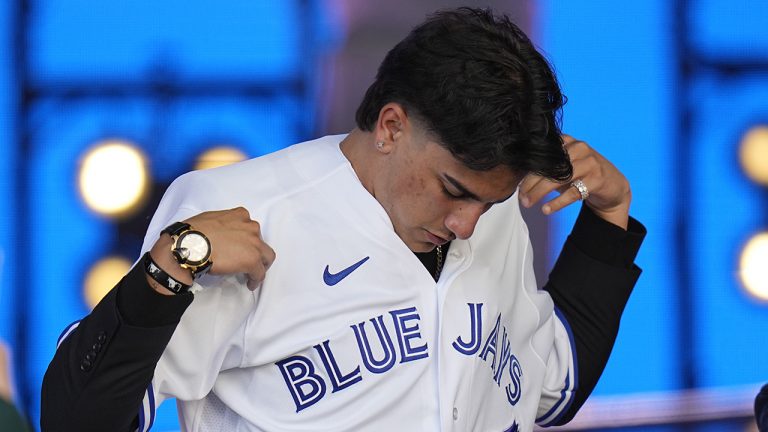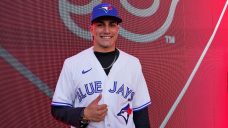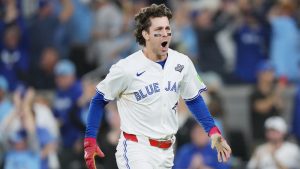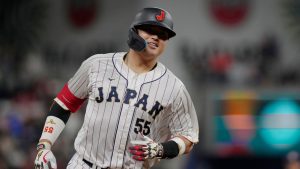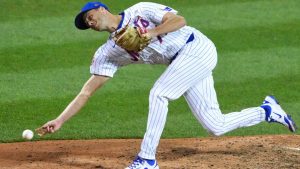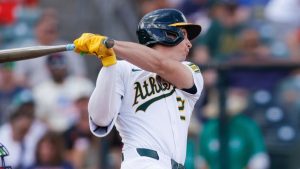TORONTO — This April, after striking out 68 batters over the first 37 innings of his senior season at American Heritage High School in Plantation, Fla., Brandon Barriera sat down with those closest to him and made an interesting decision. He chose to stop pitching.
For now, that is. The 6’2, 180-lbs. left-hander felt he’d done more than enough to demonstrate his readiness for the next level, running his fastball up to the high-90’s and whipping a biting slider past high school bats before the professional scouts that crammed the stands at each of his starts.
And he’d shown them even more on the summer showcase circuit the year prior, where he utilized his mid-80’s changeup more often against advanced hitters, while mixing in the mid-70’s curveball he’d gotten away from in high school competition where he needed only his two primary weapons.
What else did he have to gain? He had results, gaudy stuff metrics, a commitment to Vanderbilt University in his back pocket if things didn’t go his way on draft day.
And he had a cautionary tale. One of Barriera’s closest friends is Dylan Lesko, the right-hander the San Diego Padres selected No. 15 overall in this year’s draft. Lesko was trending to be selected much higher, possibly within the top five, before he began experiencing forearm soreness this spring and ultimately required Tommy John surgery.
“We have the same work ethic. We go about things the same way. And seeing what happened to him and how he went down that quick — and then also looking at the college guys and seeing top college guys go down to arm injuries — I was just going off of that,” Barriera says, reflecting on the decision to cut his senior year short. “Just looking at the bigger picture. The best thing I can do is be available. So, coming in here, I wanted to make sure that I was at the best body-wise on the field and off the field. Being able to do things with them and buy into the process here.”
“Here” is Dunedin, Fla. and “them” would be the Toronto Blue Jays, the organization that drafted Barriera with its first overall pick earlier this month, only eight selections after the Padres plucked his buddy Dylan off the board.
The Blue Jays were at all eight of Barriera’s starts this spring and, once they got to know him and the reasoning behind shortening his season, were excited to see the 18-year-old fall to them at No. 23. The club was prepared to execute multiple draft strategies depending on what was available to them towards the back end of the first round — but building around Barriera was among their preferred routes.
Once he agreed to accept a $3.6-million bonus — a little more than $500,000 north of the slot value of that pick — to keep him away from Vanderbilt, the club moved quickly to get him drafted, signed, and in uniform at its new player development facility in Dunedin.
That’s where he’ll be spending the rest of his summer into the fall, taking the first steps towards someday, he and the organization hopes, pitching for the Blue Jays in Toronto.
"It's something I've always wanted to be a part of," Barriera said. "Seeing pitchers like Jose Berrios, Alek Manoah, Jordan Romano, all those guys, their whole pitching staff, they all go out there, do what they need to do, put their team in the best situation to win. They go in day in and day out, and they don't miss a step. Being able to see that and knowing that they started off where I started off — we're all starting at the same position — and seeing how well they transitioned and go about things, I'm excited to be here and I'm excited to buy into all this stuff.”
Of course, Toronto selection of Barriera is a risky one. The attrition rate of high school pitchers taken early in the draft is substantial — whether due to injury, stalled development, or both.
But it’s easier to assume that risk when the pitcher comes loaded with an arsenal like Barriera’s. His fastball sat in the mid-90’s during his senior year, complemented by a hard slider that was registered with spin rates approaching 3,000 by his travel ball coaches. A changeup and curveball round out his repertoire, with the former featuring the potential to develop into a third plus pitch.
“The pitches in a vacuum are good,” says Blue Jays amateur scouting director Shane Farrell. “A fastball that's up to 98, pitching in the mid-90's. The slider's a really good pitch — his best secondary pitch that he has currently. He did show feel to spin and land the curveball. And the changeup's a development pitch for him. But I think looking at the overall arsenal, it's strong and advanced for an 18-year-old.”
In some ways, Barriera is like a more advanced Ricky Tiedemann, who came out of high school with a fastball in the low-90’s, a still-developing slider, and changeup. Once the Blue Jays selected Tiedemann No. 91 overall in the 2021 draft, they exposed him to a professional environment and training methods, helping him add size to his frame and iron out inefficiencies in his delivery, which quickly added velocity to his fastball and action to his slider. Now, the 19-year-old’s shooting up top prospects lists and the Blue Jays organization itself, with a double-A debut looming.
Like Tiedemann, Barriera will spend the rest of his draft year in Dunedin, undergoing much of the same programming. He won’t even step on a mound until the fall, throwing lightly on flat ground for now while focusing most of his energy on developing professional habits and routines, forming a nutrition plan, and improving his strength, conditioning, and movement patterns. His first bullpen as a professional won’t come until September.
The unusual nature of Barriera’s spring plays a role, too. He hasn’t pitched competitively since mid-April and the Blue Jays are reticent to ramp him back up to regular game action with the end of the minor league season looming in less than two months.
“I think that's why the throwing progression that our pitching coordinators have mapped out will be pretty steady, pretty thorough, and diligent with how they're bringing him along,” Farrell says. “It won't be just about throwing volume. But it'll be about incorporating everything else developmentally that goes into the player plan. Strength and conditioning, nutrition, things like that. That will ultimately determine when he's game ready.”
Barriera and the rest of Toronto’s draft class is currently working through a two-week development camp in Dunedin designed to introduce them to the Blue Jays organization, the resources it offers, and the principles it values. Among the group is Tucker Toman, the switch-hitting high school shortstop the Blue Jays selected with the No. 77 overall pick and signed for first-round money.
That $2-million bonus — more than twice the $846,900 slot value where Toman was selected — tells you everything you need to know about how much the Blue Jays like him. As does the fact the club brought Toman to their player development complex to meet front office members and staff prior to the draft.
Of course, the switch-hitting shortstop was already familiar with Blue Jays assistant GM Tony LaCava, who’s known his father — Jim, Middle Tennessee’s head baseball coach — since Toman was young. That connection was integral in the Blue Jays fostering a strong relationship with Toman over his high school years. And in the days since the draft, Toman’s hinted at having opportunities to be selected earlier for a larger bonus. That he went where he did for what he did speaks to a strong desire to join Toronto’s organization.
“Something that gave us the most confidence in making that pick was just how he goes about his work, how diligent he is, the way he grew up in the game, knowing the day-to-day grind and failure that comes along with it,” Farrell says. “A lot of amateur players have been the best amongst their peers and haven't really experienced it. But for Tucker, having a front row view to a lot of players and being able to experience their successes and failures second hand is important.
“I think it'll serve him better for the long run. Viewing Tucker recently this past week at our draft camp and even just seeing how much joy and excitement he has being at the field is really something fun to watch.”
Beyond Toman, an interesting thread that runs through the position player side of Toronto’s draft class is the glut of college hitters the club selected with demonstrated on-base skills. In the second round, they added Josh Kasevich, a right-hander who walked as many times as he struck out over three seasons with Oregon. In the third, they selected Alan Roden, whose 3.6 strikeout-to-walk ratio — the Creighton first baseman walked 29 times against only eight strikeouts across 242 plate appearances — led all NCAA Div. 1 hitters this season.
In the seventh, it was Peyton Williams, a 6’5, 255-lb. mountain of a first baseman who walked as many times as he struck out this season with Iowa. In the eighth, Dylan Rock, an outfielder who walked three more times than he struck out for Texas A&M.
All four of those players have demonstrated above-average contact ability — Kasevich and Roden in particular — against college pitching, which is no guarantee to transfer to the professional ranks but certainly better to have than to not. It’s similar to Toronto’s recent approach internationally, where it’s signed a series of high-profile, hit-first players such as Gabriel Moreno, Leo Jimenez, Estiven Machado, and Mauel Beltre.
“Contact is certainly a trait that that we value,” Farrell says. “The pitching is only going to get more difficult and swing-and-miss only increases and becomes more prevalent as they climb the ladder. So, acquiring two guys in Kasevich and Roden that have good barrel accuracy and strong contact skills are two things that we were really drawn to.”
Why seek contact over power at a time when StatCast has given us a better understanding than ever of the value of hard-hit rates? One possibility is that the Blue Jays feel their beefed-up developmental environment in Dunedin can help players add size and increase hard-hit rates more easily than it can teach them to make more consistent contact with the ball.
Many organizations league-wide, laden with young players featuring over-aggressive swings encouraged by the hunt for big exit velocity readings, are now preaching the importance of swing decisions, following in the footsteps of the Los Angeles Dodgers who made it a tenet of their developmental approach years ago. The Blue Jays could be trying to cut in the opposite direction, looking to take players who make good swing decisions inherently and teach them to drive pitches with more authority.
Nothing wrong with going against the grain. Ask Barriera, who, in shutting down his spring season early and still receiving a substantial first-round draft bonus, has charted a unique course to the pros that highly touted amateur pitchers behind him could follow. Now, he’ll try to chart his quickest possible path to the majors.
“When it comes to competing, I take that stuff real serious. It's what I love to do. I love to play the game of baseball. I'm not going to let anybody take that away from me,” he says. “It's been my dream. Coming here and doing this every day is something that I've fallen in love with and something that I've been working all my life to do.”
